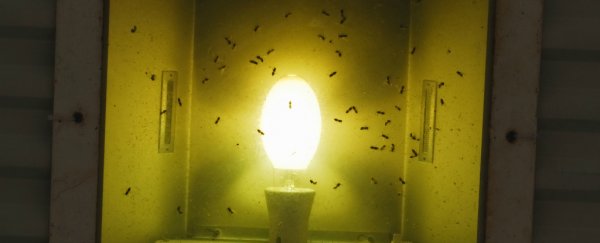If you've ever dined outside during summer, you'll know that it's a constant balancing act - if you leave the porch lights on, you risk attracting every insect within a 200-metre radius to share your dinner, but without lights, you'll spend half the meal trying to guess what's on your fork.
But the type of light bulb you choose could change that, new research suggests. An ecologist has just announced the results of a summer-long experiment, and has shown that there's a difference between the insect attractiveness of six of the most common store-bought light bulbs.
According to the results, by far the worst option for outdoor lighting was traditional incandescent bulbs, while the best (and least appealing to insects) was a warm coloured LED light - those are the LEDs that produce a yellow/orange hue, rather than cool blue light.
Impressively, the yellow-hued LEDs turned out to be even better than 'bug lights' - bulbs on the market that claim to avoid attracting insects.
The results were presented at the American Association for the Advancement of Science conference last week by ecologist Michael Justice, who has a PhD from the University of North Carolina, Greenboro.
And although most of us want to avoid attracting insects to our light bulbs for mostly selfish reasons (insects = annoying), Justice's motivations were a little more ecological.
"This is the first study to directly compare all the major types of bulbs designed for exterior residential use," he wrote in his conference paper. "A widespread shift to LED lamps could greatly reduce the impact of light pollution on insects."
To figure this out, Justice and his team set up a funnel trap outside with a single light bulb inside. They rotated one of the six different light bulbs in the trap each night, and every morning counted the number and type of insects that had fallen in.
To ensure the brightness of the Moon wouldn't interfere with the results, they mapped the stages of the Moon across the three-month period, and made sure each type of bulb would be exposed to the same share of moonlight.
They also did their best to control for the weather, Justice explained to Esther Inglis-Arkell over at Gizmodo.
"If the weather during insect trapping with one bulb were substantially different than the weather with another that would confound the results," he said. "Luckily we were able to minimise that by studying weather forecasts and crafty scheduling of which bulb was used on what nights."
By the end of the summer, he'd captured a total of 8,887 bugs in the light trap. And it was clear that some bulbs had proven much more attractive than others.
Overall, incandescent light bulbs pulled in the highest number of insects, followed by CFL, halogen globes, and cool-coloured LEDs. The second best light was the 'bug light', and the winner, with the least amount of insects attracted, was the warm LED bulb.
Although most of the results weren't surprising, Justice was shocked that the bug light didn't perform better, seeing as it was advertised as being specially designed to reduce insect attractiveness.
It was also the only bulb that drew certain types of insects in unequal numbers - the bug light pulled a significantly larger number of insects from the order Hemiptera, which includes stink bugs, and Dermaptera, which includes earwigs.
"The only thing we could hypothesise in advance is that the yellow 'bug' light would catch the fewest insects," said Justice. "We were very surprised when not only was that not the case, but the yellow bulb attracted a lot of earwigs, which can be a household pest."
To be clear, the research hasn't been peer-reviewed or published in a journal as yet, so it needs to be taken with a grain of salt. But the results did convince the organisers at one of the world's most reputable conferences that they were worthy of presenting, which is no easy feat.
So for now, stick to warm-coloured LED bulbs to light your garden or porch this summer. Not only will it reduce the amount of insects hanging around, it's also a lot better for the environment than traditional globes. Win/win.
